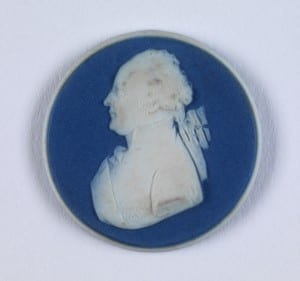The Age of Revolutions
By Jenny M Wedgbury, on 29 February 2016

Josiah Wedgewood (1730 – 1795), Philippe-Égalité, 1790-2 (White jasper ware, dipped in dark blue, applied jasper ware reliefs)
Blog post for UCL Art Museum, Revolution under a King exhibition by Dr Susannah Walker, UCL Art History Department
On 10th February I joined Dr Richard Taws, the co-curator of UCL Art Museum’s current exhibition Revolution under a King: French Prints 1789-92, to give a lunchtime lecture on the prints in the so called “Age of Revolutions”.
A bewildering succession of governments followed the French Revolution of 1789. Between 1789 and 1848, the longest reigning regime was the July Monarchy (1830-1848) which held power for only eighteen years. Civil and international wars, militarization and Imperial conquest under Napoleon, Restoration reaction and Napoleon’s attempted coup of the “Hundred Days” unfolded during this turbulent half century. Yet for all the realities of violence, division and upheaval, this was a period of intense intellectual activity and artistic innovation. Print culture provides fascinating insights into this dichotomy.
Producers of visual culture were compelled to keep pace with frequent momentous events and transformations in power relations. Revolution in 1789 had precipitated the breakdown of traditional structures of patronage from church and state and new art markets were established. Individuals whose political views had once been sympathetic to the regime in power could find themselves unceremoniously pushed into opposition and dissent. These conditions were conducive to forms- like the print- which were portable and easily reproducible. Prints, like portrait miniatures, could be privately purchased and either proudly displayed as a sign of allegiance or hidden away as clandestine possessions.
Novel visual languages had to be established to communicate unprecedented events. Artists often combined new with old and elite with vernacular forms in unexpected ways to achieve this. Revolution in 1789 produced an image culture where classical figures of liberty vie with fantastical demonic figures of counter-revolution. Seemingly conventional engraved portraits gain more complex meanings when we realise that they are images of revolutionary personalities. The heightened political stakes of the portrait are exemplified by the anonymous print of Louis XVI wearing the bonnet-rouge and the clandestine representation of royal profiles torn into the margins of a print in the exhibition.
Meanwhile, the destruction of symbols of monarchy made way for new types of representation. The exhibition demonstrates that the image of the Fall of the Bastille migrated from pro to counter-revolutionary prints which marked this event. The entrepreneur charged with the Bastille’s demolition, Pierre-François Palloy manufactured miniature Bastilles out of the dust harvested from its dismembered structure in a venture that is echoed today in the mass production of souvenirs and conceptual art alike!
The inventiveness of post-Revolutionary print makers is brought into sharp focus by the development of lithography in France in the late 1810s. A less laborious method of printmaking than engraving and capable of higher print runs, lithography was also able to reproduce the line and tone of the artist’s drawing and produced a range of visually interesting surface effects. It became a favoured method for representations of Napoleonic nostalgia and political prints during the Bourbon Restoration. However, it was in the early years of the July Monarchy that an inventive and highly personal satirical form of political caricature came to the fore and mocked the regime for its failure to deliver on the revolutionary promises of 1830. During this period the carnivalesque, classical and fantastic languages and motifs already present in Revolutionary etchings are used to their most incisive comic ends by contributors to La Caricature.
La Caricature’s editor, Charles Philipon was a talented organiser and provocateur who worked collaboratively with a talented group of artists to develop a visual language to attack the July Monarchy. His best known gesture of irreverence was to draw a sequence of images showing Ling Louis-Philippe’s head metamorphosing into a pear at a trial for lèse majesté in 1831 to demonstrate in his defence that anything could be said to resemble the King! The pear subsequently became a widely recognised symbol of the monarch and his government and is a recurrent pictorial code in La Caricature. UCL Art Museum’s collection includes several further thinly veiled representations of Louis-Philippe and his ministers disempowering the figure of Liberty. In comparison to the exhibition’s content, these images are responses to the tension between liberty and the body of the King already present in the representation Louis XVI wearing the bonnet-rouge. They are outcomes of the process of desacralization of the King commenced in 1789 and part of a recognisably modern discourse of political caricature.
Despite a wealth of excellent scholarship, prints can be overlooked, treated as the “context” for canonical painting or as simple illustrations of historical events. The lecture gave Dr Taws and I the opportunity to share our engagement with print culture developed by UCL’s History of Art Department. Teaching and collecting by the exhibition’s co-curator Professor David Bindman was an important factor in shaping our understanding of prints in this period. Art in the Age of Revolutions and the History of the Print were taught as MA options fortunate generations of students by David Bindman, Tom Gretton and Helen Weston for a number of years. The subject continues to be a specialism of the department, taught at both undergraduate and postgraduate levels. Our lecture invoked what might paradoxically be described as traditions of Revolutionary images. We hoped to emphasise that study of the Revolutionary print is also a dynamic and important tradition in UCL’s teaching of Art History.
The exhibition Revolution under a King: French Prints 1789-92 runs from 11 January – 10 June 2016 and is open Mon-Fri, 1pm-5pm in the UCL Art Museum. For more information, and to visit the Art Museum please go to our exhibition website.
Dr Susannah Walker is a lecturer in the UCL Art History Department
 Close
Close

